What do you know – a Wattle Q & A
Which wattle is Australia’s floral emblem?
The Golden Wattle (Acacia pycnantha) is Australia’s official floral emblem.
This beautiful Acacia species was proclaimed as our emblem on 1st September 1988 but it had been the unofficial floral emblem of Australia by popular choice for many years.
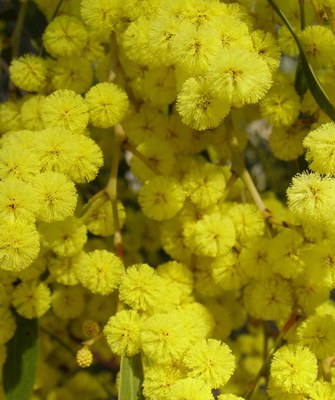
- Golden wattle (Acacia pycnantha), Australia’s national floral emblem since 1988. Photo: S.D. Searle
Stylised wattle has appeared as a floral motif on many official government documents such as an adornment to the Commonwealth Coat-of-Arms adopted 19 September 1912.
©S.D.Searle
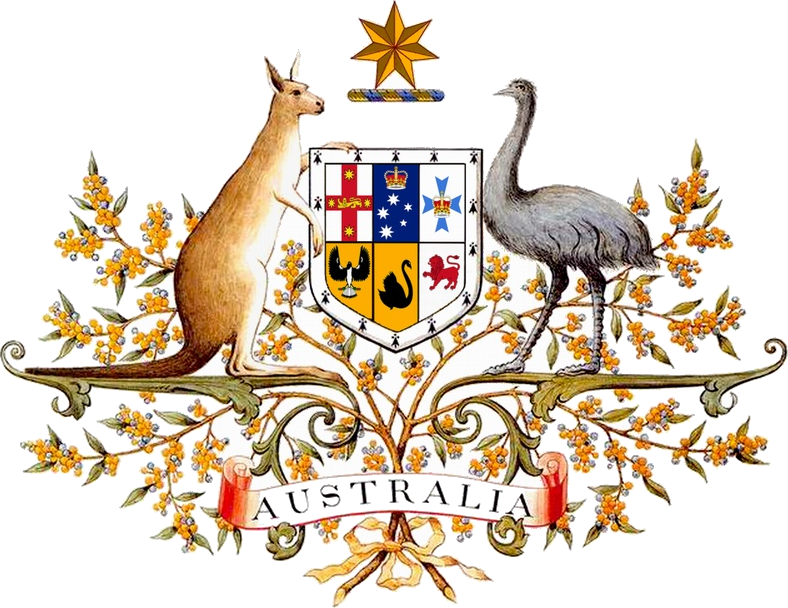
Have you seen the Governor-General of Australia’s crest with its stylised wattle?

The Honourable Dame Quentin Bryce showing
Rosary Primary School school children and their Principal (Maureen Doszpot)
the wattle on the crest pictured on her stationery when she was Governor-General of Australia.
©S.D.Searle
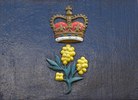
This photo of the Governor-General’s crest was taken at the gate to Government House in Canberra.
It shows a stylised wattle underneath the Sovereign’s crown.
©S.D.Searle
How many different species of wattles are native to Australia?
Australia is the land of the wattle. More than 1,070 wattle species belonging to the genus Acacia, have been described by botanists up until 12 May 2022. Nearly all of these (about 98-99%) are endemic, i.e. they only occur in Australia. More have yet to be described.
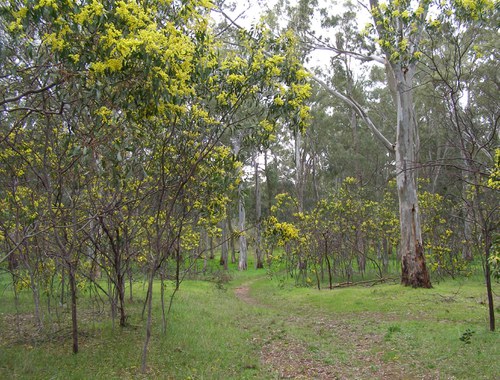
Golden wattle (Acacia pycnantha) flowering in the understory of a eucalypt forest
in Pine Reserve South Australia
Photo: ©S.D. Searle
What does ‘wattle’ mean?
The word “wattle” was originally an Anglo-Saxon word that referred particularly to a pliant woody branch or a barrier made from such branches. Early British settlers around Port Jackson (now Sydney) used the pliant stems and branches of local trees as wattles to make the framework for their homes which were daubed with mud. These early homes were called “wattle-and-daub” huts. The word “wattle” was then used to describe the trees and shrubs used for wattles, and it soon became a word used almost exclusively for species of Acacia .
What about the common names for wattles?
Common names for different species of wattle often describe how the bark or foliage looks or smells; such as Black Wattle or Green Wattle (Acacia mearnsii), Flax Wattle (Acacia linifolia) and Sweet Wattle or Sweet-scented Wattle (Acacia suaveolens).
Sometimes very different looking Acacia species have the same common name which can be confusing. For example black wattle is used to describe both Acacia mearnsii (from south-eastern Australia) and Acacia auriculiformis (a tropical species from Qld and NT).
Many wattles have aboriginal names and some of the most prominent are Boree, Boree Wattle or Western Myall (Acacia pendula and several similar species), Mulga (Acacia aneura and several other species), Nelia or Nealie (Acacia loderi) and Yarran (Acacia omalophylla, sometimes spelled as Acacia homalophylla).
Indigenous use of wattles?
Indigenous Australians used wattles routinely for a very wide range of purposes: from food and medicines, to utensils such as digging sticks and barbs, weapons (clubs, shields, boomerangs, spear throwers, spear shafts and heads), for musical instruments such as clap sticks; firewood, ash, glues, string, dyes and waterproofing, sandals and head decorations, ceremonial items and seasonal signals. One species, Acacia kempeana (Witchetty Bush), native to Western Australia, Northern Territory, South Australia and Queensland, is home to the Witchetty Grub, a valued food. More information
What do wattles mean to Australians?
On 1 September 1910 the Sydney Morning Herald stated:
“To many Australians the wattle stands for home, country, kindred, sunshine and love, every instinct that the heart most deeply enshrines.”
Where do wattles grow in Australia?
Wattles grow in nearly all parts of the Australian continent and Tasmania and often clothe the countryside with masses of green and bright golden yellow particularly in springtime in southern Australia. Most northern Australian species flower during Autumn and Winter but a few flower during spring. Wattles are very prominent in arid Australia but uncommon in dense rain forests and alpine regions. In some places, wattles are dominant, particularly in some of the drier regions of the continent but in others they inhabit only the shrub layers in woodlands and forests, especially in eastern, south-eastern Australia and far south-western Western Australia.
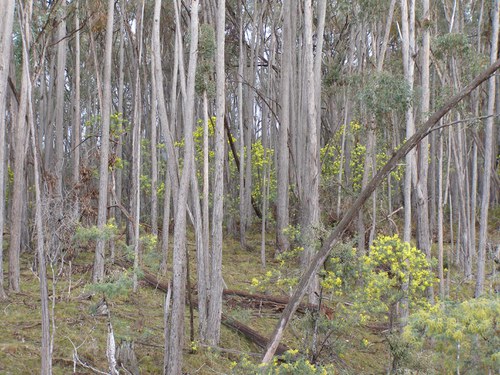
Silver wattle (Acacia dealbata growing as an understory species in a eucalypt forest
near Yackandandah Victoria Photo ©S.D. Searle
Which Australian state has most wattles?
Western Australia has about 450-500 different wattles and most of these occur in the south-western part of the State.
Do any wattles live in alpine regions?
Most wattles live in dry, arid, tropical or sub-tropical regions but two species occur high up in the Australian and Tasmanian alpine and subalpine regions. One of these, Acacia alpina (Alpine Wattle) is confined to the montane and subalpine regions of the Australian Alps between 1,300 m (4,500 feet) and about 1,800 m (6,000 feet) and it ranges from Lake Mountain near Marysville in Victoria to Cabramurra in the Snowy Mountains, New South Wales with an isolated occurrence in the subalpine mountains in the south of the Australian Capital Territory. The Variable Sallow Wattle (Acacia mucronata), also known as the Narrow-leaved Wattle, reaches an altitude of about 1,000 m (about 3,200 feet) in Tasmania. Both of these wattles can survive under snow for months.
How long do they live?
Most wattles are short-lived and will live no longer than 10-20 years but a few are long-lived (up to 200-300 years). For example, the Western Myall of Queensland, New South Wales and Victoria, also called Boree or Boree Wattle, (Acacia pendula) lives to 200 years or more, as does Blackwood (Acacia melanoxylon).
The Western Myall of Western Australia and South Australia (Acacia papyrocarpa) is known to live about 250 years.
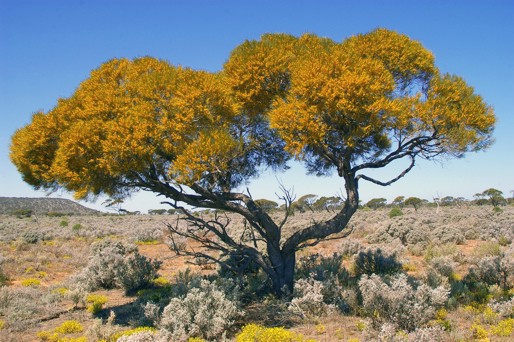
Western Myall Photo: Tony Robinson Courtesy of the World Wide Wattle website.
Photography by Tony Robinson. Image used with the permission of the Western Australian Herbarium, Department of Parks and Wildlife (https://florabase.dpaw.wa.gov.au/help/copyright). Accessed on Friday, 15 July 2016.
What are wattles used for?
Wattles are very important environmentally and economically. They are vital components of Australia’s many and varied ecosystems with their proven capacity to take up nitrogen from the air in the soil through an association with bacteria that lives in the wattle roots. Wattles provide shade, shelter and fodder where they grow in often harsh landscapes, and are used for ornamental plantings, roadside plantings, erosion control, mining rehabilitation and other revegetation programs.
Timber from wattles is used for high quality furniture and veneers and turnery.
This benchtop and stool are made from Blackwood (Acacia melanoxylon)
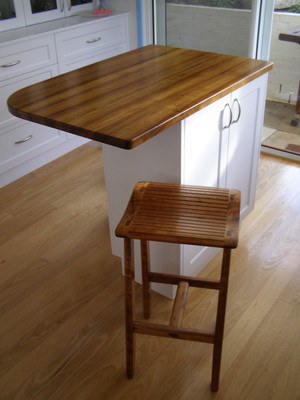
Photo: ©S.D. Searle
Wattle seed from some Acacia species is known to be safe to eat and is used in the bushfood industry.
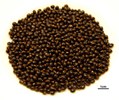
Wattle wood is a good firewood, burning hot and quickly.
Are Australian wattles grown overseas?
Australian wattles have been planted overseas for more than a century; as attractive garden ornamentals, as glorious cut flowers; for their fragrant flowers to make perfume in southern France and in large plantations in Africa and south-east Asia for their wood (for making paper and composite wood products) and bark (for tannin to use for tanning leather and making wood glues).
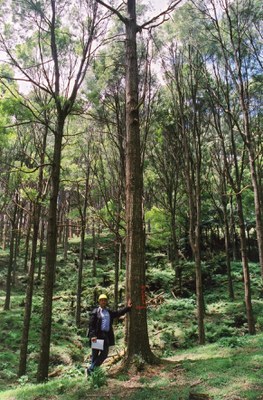
Blackwood (Acacia melanoxylon growing in New Zealand)
Photo: ©S.D. Searle
Is it true that some wattles don’t have true leaves?
Yes, in fact the majority of wattles lack true leaves when they are mature plants. However, they all have true leaves (which are bipinnate and fern-like) when they are seedlings.
A minority of species, retain true leaves throughout their life but with nearly all the others, true leaves are replaced with structures technically called phyllodes. Phyllodes take on many different shapes: these may range from flattened and broad [up to 30 cm wide in one species (Acacia dunnii, appropriately known as Elephant Ear Wattle)] or cylindrical and needle-shaped or occasionally completely absent. Some have thick stubby phyllodes not more than 1-2 mm long.
Are all wattle flowers yellow?
Most wattle flowers are golden yellow or shades of yellow, but there are exceptions.
One wattle (Acacia purpureopetala) in north Queensland has mauve-pink flowers, and another in south-western Western Australia has white flowers (Acacia gilbertii). In Victoria two unusual plants have been found in recent years; one with with red flowers and the other with orange flowers.
The plant with red flowers was found in Victoria 1995 by two bush walkers – Acacia leprosa ‘Scarlet Blaze’.
It became Victoria’s Centenary of Federation floral emblem and can be bought through nurseries.
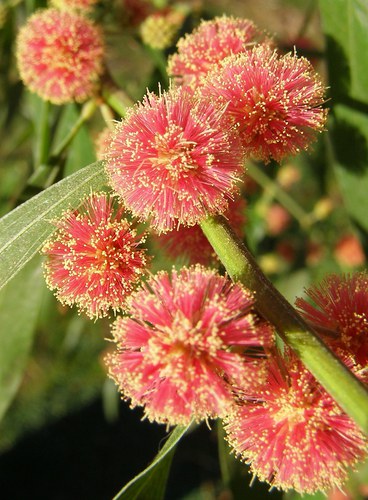
Scarlet Blaze (Acacia leprosa) with its unique
red wattle blossoms
Photo: ©S.D. Searle
Another has been found with orange flowers. One branch of an acacia called Hedge Wattle (Acacia paradoxa) was found with brilliant orange flowers by Wendy Marriott in 2007 near Stawell Victoria. (Yellow flowers were also blooming on the same plant). Cuttings have been propagated and called ‘Marmalade Hedge’.
What are the tallest and shortest wattles?
Acacia bakeri (White Marblewood also called Baker’s Wattle or Scrub Wattle) is the tallest and has been recorded at nearly 50 m high with a trunk 1.5 m in diameter. White Marblewood is native to south-eastern Queensland and north-eastern New South Wales. Blackwood (Acacia melanoxylon), native to South Australia and all eastern states of Australia and including the Australian Capital Territory has been known to reach 30 m (100 feet) but large trees are now very rare.
There are several wattles which may be only a few centimetres in height. One of these, Acacia aculeatissima (Snake Wattle) grows in south-eastern Australia (far South-eastern New South Wales and Victoria).
However most wattles are shrubs less than 3-4 m high. Some others barely reach 10 centimetres high and others creep along the ground. Two wattles in far northern Queensland are lianas.
Are there any ‘weedy’ wattles ?
Some species of wattles are invasive and care should be taken in using these as garden subjects, particularly outside their natural range. The following species may be troublesome in some regions: Cootamundra Wattle (Acacia baileyana); Snowy River Wattle (Acacia boormanii); Knife-leaved Wattle (Acacia cultriformis); Silver Wattle (Acacia dealbata); Sydney Green Wattle (Acacia decurrens); Mountain Cedar Wattle (Acacia elata); Sydney Golden Wattle (Acacia longifolia); Queensland Silver Wattle, also called Mount Morgan Wattle (Acacia podalyriifolia); Golden Wattle (Acacia pycnantha has become invasive in the Perth District, Western Australia) and Orange Wattle, also called Golden Wreath Wattle (Acacia saligna).
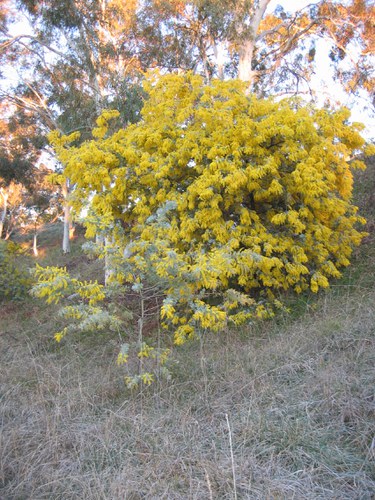
Cootamundra Wattle (Acacia baileyana) with seedling growing downslope
Photo: ©S.D. Searle
Several wattles have become troublesome overseas, especially in South Africa where, for example, the Golden Wattle (Acacia pycnantha) and Sydney Golden Wattle (Acacia longifolia) have become weeds.
Another species, Georgina Gidgee (Acacia georginae), is very poisonous and is particularly dangerous to sheep and cattle. It is indigenous to Northern Territory, far northern South Australia and Queensland. For further information on this species, see S.L. Everist, Poisonous Plants of Australia, Revised Edition (1981).
Are wattles easy to grow and which species are the best?
This is a very difficult question to answer because there are so many different species and they grow in many different soils and climatic conditions. However, most wattles are easy to grow and a visit to your local nursery should be useful to find out which species will suit your particular needs and local conditions. Their early rapid growth in the first 2-3 years after planting can make them very useful if you want to establish a garden or visual screen or animal habitat or stop erosion quickly.
